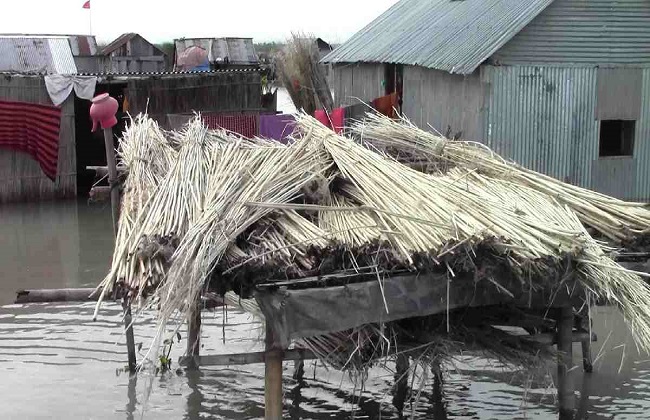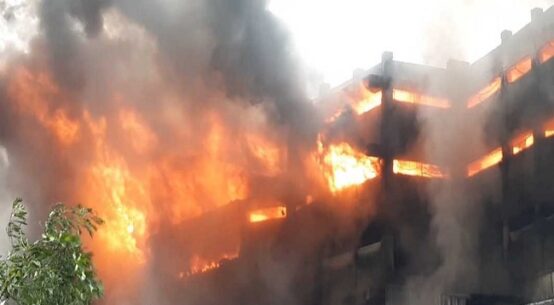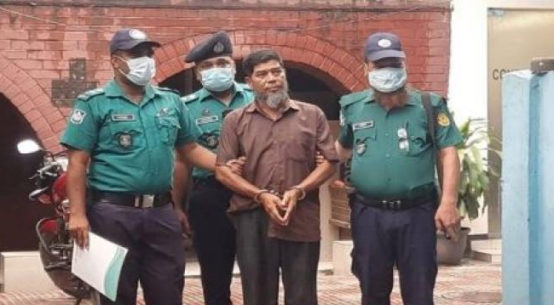
Sitting on the bank of the Brahmaputra River, Sukhi Begum, 70, recalled the misery she experienced during in her life due to floods and riverbank erosion.
Her family was first displaced about 50 years ago when she was only 20. And she has, since then, lost her homes seven times due to the erosion of the mighty river.
“We came to Pakuar Char of Sariakandi in Bogura around 50 years ago. But I still remember the day when we were first displaced due to riverbank erosion,” said Sukhi Begum, a mother of five, living in Pakuar Char.
“That time, I was younger and we were compelled to move to another char of Brahmaputra seeking a safe shelter. We built homes there to start a new life but the river devoured our homes making us destitute time and again,” she recalled.
Sukhi was born and grew up in chars and has passed almost her entire life in the chars. So, she knows how to maintain the char life.
She said flood is a common phenomenon in the chars of Brahmaputra River and that is why they always remain mentally ready to shift their homes, as flood often causes riverbank erosion and the erosion makes them displaced.
“Despite experiencing the flood, we do not want to leave our homes. We stay at home during the flooding by setting up the increased structures at our houses. But when the river eats up our homesteads, we have no choice but shifting homes,” she added.
Sukhi said she wants to breathe her last in the char as its fertile land gives her shelter and livelihood options. “I was born in char and want to breathe my last in the char too,” she added.
Despite having uncertainty, farmer Ziaur Rahman, 34, had sowed jute seed on a fallow land of a newly emerged char in the Brahmaputra River but flood washed away his crop this year too.
“We, the char dwellers, face normal flooding every year and I knew we must experience a devastating flood this year. Despite that, I sowed the jute seeds on the char because we live in char with hope. Although my jute field was damaged by flooding this year, I will get bumper production of the next crops in dry season,” he said.
Explaining how he can predict about flooding, Ziaur said the char dwellers can understand when a flood will hit.
“Based on the water coming from the upstream areas in the Chaitra month of Bangla calendar, we can understand whether a flood is coming or not in the monsoon,” he added.
As a huge volume of water came from the upstream areas in this Chaitra month, a big flood swept in Brahmaputra basin earlier during this monsoon, Zillur said.
Before the flood hit, Ziaur shifted his home to another char of Brahmaputra, which was relatively safe, from Pakuar Char where he had been living for the last four years.
“As I assumed that a big flood was coming in this monsoon, I relocated my house to a char of Sariakandi,” he said.
People living in the Brahmaputra chars know that their miseries will worsen during the monsoon as their neighborhoods will be inundated even in a normal flood. The floodwater inundates the roads, local markets and homesteads in the chars, accelerating their plights.
When flood comes, the people must take shelter on boats, banana-plant-made rafts and lofts (platform) built inside their houses.
“When flood inundates our homesteads, we must live on lofts built inside our houses or on boats or the rafts. When the situation gets worst, people take shelter in the shelter centres. But we do not want to go there leaving all belongings behind,” Ziaur said.
Mozam Mondal of Char Shovagacha said they must keep their domestic animals on floating platforms made of banana plants and face problems in managing fodder for those.
During a flood, the boats and the rafts are the only means of communication for the char dwellers as all the earthen roads go under floodwater.
Mozam Mondal said the char dwellers are the poor and vulnerable ones and most of them have no boat, so they use banana-plant-made rafts for going from one place to another, which is very time consuming.
Flood also submerges tube-wells and toilets in the chars, putting the people in an acute crisis of drinking water and sanitation.
“As our toilets go under floodwater, we must go for toilet on open water by using boats or the rafts, polluting the water,” Mozam said.
Floods affect the life of all the char dwellers but women and children are more vulnerable to flooding and other natural disasters. Amid the flood situation, the women have to manage their household works, prepare meals and collect drinking water.
As most of the tube-wells, the only source of safe drinking water in chars, go under water during a flood, women sometimes have to collect drinking water travelling one kilometre or more by boats or rafts or on feet through knee-to-chest-level floodwater.
“Collecting drinking water is a hard task indeed. We have to go a long distance to collect water by boat or banana plant-made raft,” said Mahmuda Begum, a char dweller of Damudurpur of Sarisabari upazila in Jamalpur.
Sima Begum, 60, a mother of five who built home at Char Shovagacha last year after getting displaced, said when the flood hits her locality every year, people must live on boats or the banana-plant-made rafts.
“Even we have no alternative to living on boats or the rafts during a flood. Frequently, our children sink in floodwater and die. It is very common here,” she said.
There is no enough education facility for children in char areas. Temporary schools built in the chars are flooded every year, disrupting the teaching of children.
“Children of chars cannot go to schools even during a normal flood as those go under water and remain closed for one to two months a year,” said Abdur Rahman of Pakuar Char at Sariakandi.
Women in chars are highly vulnerable to flooding since they have the responsibility to take care of their children and elderly family members apart from collecting drinking water, cooking food and rearing the domestic animals, said Dr Muhammed Forruq Rahman, research and advocacy manager of Network on Climate Change, Bangladesh (NCC,B).
He said since the adolescent girls and women have to stay on embankments or shelter centres during floods, they are vulnerable to sexual harassment too.
The women also suffer more during floods for lack of toilet facility.
“As the flood inundates all of our latrines, we have to go for toilets using rafts at night. We, the women, cannot use toilet at daytime during a flood, so we eat less food to avoid toilet at daytime, increasing our health complications like kidney problems” said Afroza Begum of Char Nadaghari.


